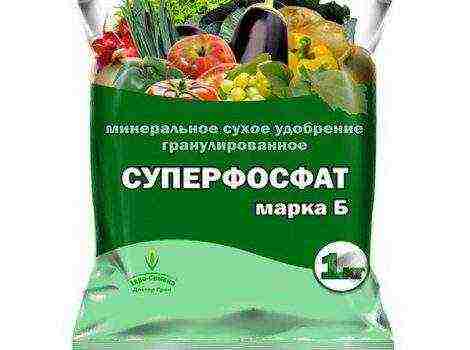Content
- 1 Correct planting dates and daikon care
- 1.1 What is Japanese daikon radish
- 1.2 Features of different varieties
- 1.3 Is it possible to grow daikon in the garden
- 1.4 Timing for landing
- 1.5 Agricultural technology of sowing seeds for growing vegetables
- 1.6 Sowing seeds for seedlings
- 1.7 How to plant in open ground
- 1.8 Care rules
- 1.9 Disease prevention
- 1.10 Harvesting and storage
Correct planting dates and daikon care
The range of vegetable crops grown on their site is expanding every year. This is due to the growing tendency to replenish the diet with wholesome and nutritious dishes, has properties that have a beneficial effect on health. Among the new varieties of plants, the cultivation of which are beginning to be actively developed by gardeners, not the last place is occupied by daikon. Landing in the country is not difficult, the main thing is to observe the landing dates and the rules of care.
What is Japanese daikon radish
The homeland of a promising culture is Japan. There, the radish variety is incredibly popular due to its rich vitamin composition and delicate taste, so the sweet vegetable is included in the daily diet.
Daikon belongs to the cruciferous family with a one-year cycle. The shape of the vegetable is similar to a radish and can be different. from conical to serpentine... The differences are explained by the belonging of the vegetable to one or another variety.
The weight of the root crop depends not only on the varietal factor, but also on weather conditions, compliance with the rules of agricultural technology, therefore the range of average indicators has such a large take-off - from 500 gr. up to 3 kg... The length of the vegetable reaches 10-60 cm at diameter 4-8 cm.
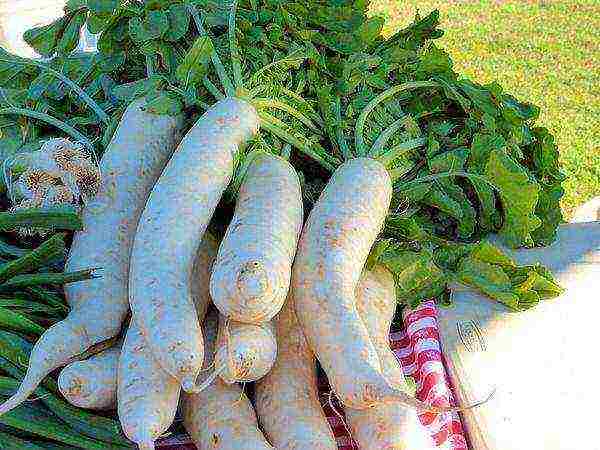
Daikon Features:
- cold resistance (seedlings tolerate frosts up to minus 4 degrees, adult plants - up to minus 6 degrees);
- good lighting and a long day are required for normal vegetation;
- unpretentiousness to the type of soil;
- early maturity (50-70 days).
Features of different varieties
For those gardeners who are going to plant a daikon on their site for the first time, it is recommended to opt for the following popular varieties.
Sasha
Daikon Sasha refers to early varieties with a growing season 35-45 days... The shape of the root crop is round white, weight is 200-400 grams. with a diameter of 10-11 cm. When a plant is grown, half of the fruit rises on the soil surface, this facilitates harvesting.
The taste and nutritional value of daikon allow it to be included in the diet of dietary and baby food.

Dubinushka
Dubinushka - culture mid-season ripening period with vegetation 43-54 days... Elongated-cylindrical fruits up to 50 cm long outwardly resemble a club, hence the name of the variety. The average weight of a vegetable is 500-2000 gr., its pulp has a sweet and delicate taste without bitterness, dense structure.
The crop perfectly retains its valuable vitamin composition during long-term storage.
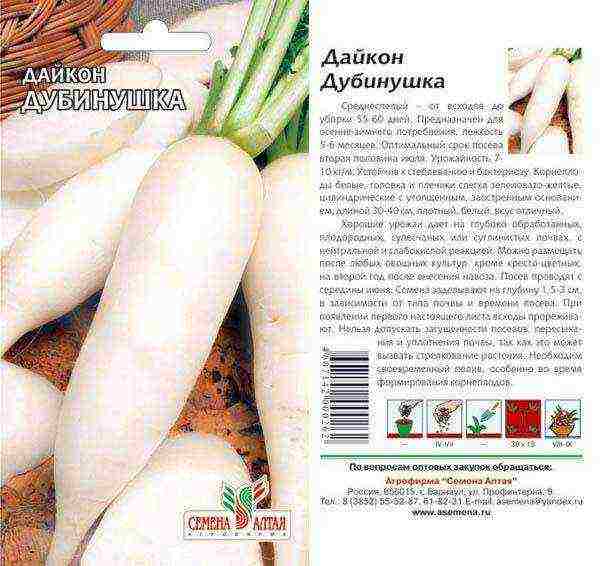
The Dragon
Daikon root vegetables ripen through 60-70 daysth after emergence. The shape of the vegetable is cylindrical with a conical top, weight - 900 gr. with a diameter of 6-8 cm. The taste of the fruit is very delicate, refreshing with a hint of sweetness, the pungency is not felt in it. The structure of the pulp is dense.
The dragon is suitable for long-term storage, even in winter the radish is filled with vitamins and minerals valuable for the body. This allows the daikon to be used for diet food, as well as sports and children's food.
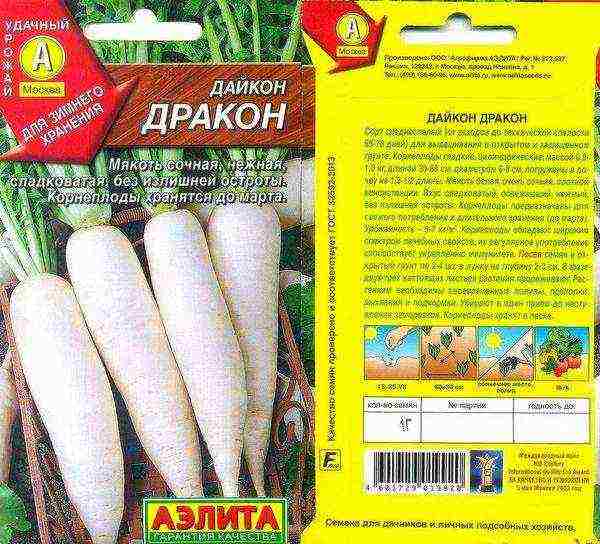
Elephant fang
Mid-season daikon variety with vegetation 80-84 days... Cylindrical fruits protrude 2/3 of their length when grown above the soil surface, which facilitates the harvesting process. Vegetable length - 18-25 cm, weight - 500-600 gr. with a diameter of 7-8 cm.
Feature of the variety: easily tolerates dry summers, high stable yield.

Is it possible to grow daikon in the garden
The cultivation of daikon has long been mastered by gardeners from different regions of Russia. In the south of the country and in the middle lane, sowing is done in early spring, and sometimes in autumn. With such a planting, you can get a crop already in June or early July.
In Siberia and the Urals, radishes are more often grown in greenhousesto prevent young shoots from freezing. In addition, the climatic conditions of these regions are far from ideal. Heavy rains eroding the beds along with crops create many problems, as well as strong winds. To reduce the risks of crop loss, gardeners have gotten used to growing vegetables under cover.
According to its characteristics, daikon belongs to cold-resistant plants, but this does not mean that the plant will develop at low temperatures. For normal vegetation, indicators should not fall below 10 degrees... With a long stay in the cold, the crop slows down growth and takes root poorly, which significantly reduces the yield.
When landing on open ground in regions with a harsh climate, it is recommended to consider the following factors:
- daikon variety (you need to use early and mid-season radish varieties so that they have time to ripen);
- compliance with the terms of sowing seeds in the ground;
- the creation of a film shelter after disembarkation.
Timing for landing
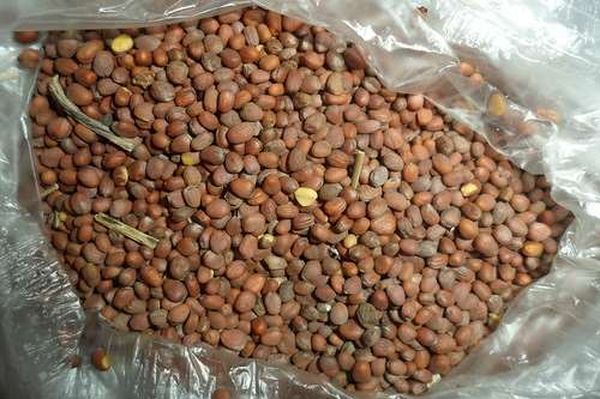
Daikon can be planted by seed and seedlings... The option is chosen taking into account the characteristics of the variety: the fruits of a round and shortened-oblong shape are more suitable for the seedling method, and the elongated ones are for the seed method, since there is a risk of damage to the root system during transplantation.
In open ground, seeds can be planted during the period from 20 April to 10 May... When growing seedlings, sowing is planned from March 15 to April 10... Seedlings are planted in open ground in about a month, when 2 pairs of true leaves are formed.
Experienced gardeners come up with various tricks to protect the crop from shooting, because in this case we are not talking about the development of root crops. Some plant seeds in early spring, others manage to sow them in the fall.
Agricultural technology of sowing seeds for growing vegetables
Seed preparation
Before sowing the seeds should be warmed up in a thermos filled with water 50 degrees. The selected disinfected grains are immersed in it for 20 minutes, after which they are immediately placed in ice water. After such stress, the seed must be sent to the refrigerator for a day (on the door or in the vegetable compartment).
Soil preparation
Daikon is considered a very convenient vegetable for cultivation, as it adapts to any type of soil. However, experienced gardeners recommend using a fertile soil of a loose structure. You also need to pay attention to the environment, it should be neutral or slightly acidic.
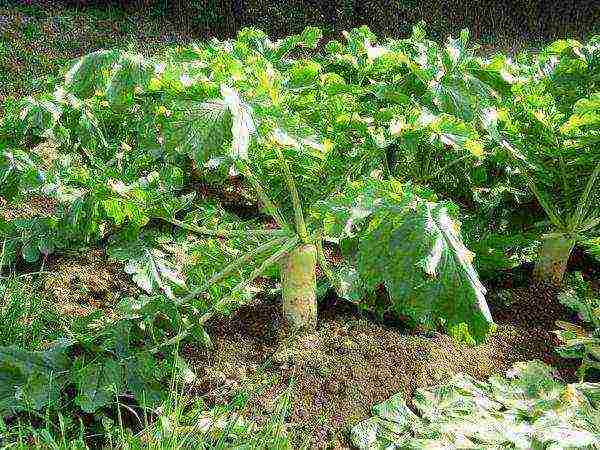
To enrich the soil, you need to introduce the following nutrients into it in the fall:
- humus or compost - 1-2 kg / m2;
- superphosphate - 40 g / m2;
- potassium sulfate - 20 g / m2.
If lime is used to reduce acidity, then it should be applied separately from fertilizers at intervals of 2 weeks.
Sowing seeds for seedlings
Daikon sow 2-3 seeds in peat tablets or peat-humus pots... When using containers, it is worth considering the required depth - at least 10 cm.
Lay the grains to a depth in the moistened fertile soil of a loose structure 1.5-2 cm... The surface of the container is covered with glass or foil and placed in a warm place.
After 5-7 days after the emergence of seedlings, the shelter is removed, and the seedlings are exposed in a well-lit place. After the formation of the first pair of leaves, weaker shoots are removed.
Daylight hours for seedlings shouldn't be too longas this promotes greenery growth rather than root formation.

How to plant in open ground
In open ground, daikon seedlings are planted according to the scheme: 30x60 cm... The grains are placed in the hole 2-3 pcs., While the seeding depth should not exceed 2 cm. It is necessary to plant seeds or seedlings into moist earthso that they quickly adapt and begin to develop.
After planting work, it is necessary to irrigate by spraying, and mulch the soil surface with peat. When the temperature drops, it is recommended to cover the bed with plastic wrap or agrofiber.
Care rules
An unpretentious plant still needs basic care, which includes the following activities.
Watering
Throughout the growing season of the daikon, the soil must be moist. The first watering is carried out after the emergence of seedlings. The lack of water provokes the release of arrows, so the procedures should be performed regularly - 2 times per week, and in hot weather daily.
Loosening and weeding
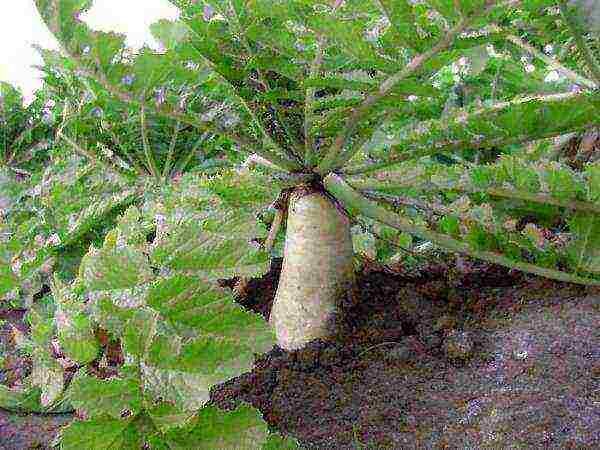
Daikon loves loose soil structuretherefore it should be fluffed weekly, especially after heavy rains. It is rational to combine the aeration procedure with weeding.
Top dressing
In the case of growing a vegetable on well-cultivated soils, there is no need for feeding. For other cases, it is recommended to make mineral fertilizers with irrigation:
- 10 liters of water;
- 10 liters of slurry;
- 4 gr. potassium sulfate.
Disease prevention
Humidity combined with high temperatures provokes the development of fungal infections. As a preventive measure, disinfection of soil and seeds before planting, as well as weed control... The moisture content of the soil is regulated so that water does not stagnate in the upper layers.
Harvesting and storage
The harvest time depends on the variety, in particular the growing season. Mid-season varieties ripen one and a half to two months after planting.
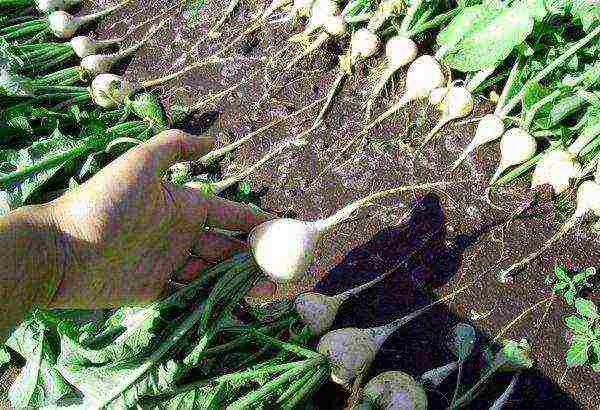
Root vegetable extracted from the soil using the foliage... This should be done in dry weather so that moisture does not affect shelf life. If the soil has adhered to the vegetable, you need to let it dry, it will disappear by itself. When removing soil mechanically, there is a high probability of damage to the delicate skin.
For long-term storage, whole fruits are selected without signs of damage. When used as cellar storage, it is recommended to stack vegetables in wooden boxes and sprinkle each layer with sand. Stocks should be checked periodically. If any damage is noticed, the spoiled daikons are removed from the box.
The agricultural technology of growing Japanese radish is simple, so you should try to grow an incredibly healthy and tasty vegetable on your site. And at the end of the season, boast of a record harvest in front of neighbors or treat them with some delicacies from a refreshing vegetable.
